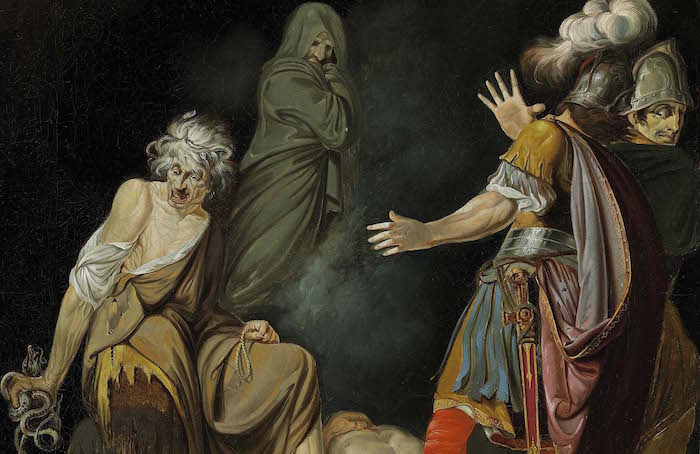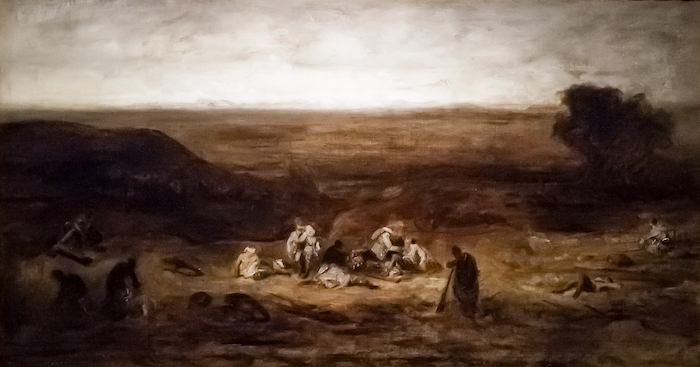Ancient Greece was full of legends about witches in Thessaly, a wild region in the north. The Roman poet Lucan (39-65 A.D.) channeled the most horrid of these in his Pharsalia. This epic poem about the Roman civil war between Caesar and Pompey includes an aside where Pompey’s son consults a monstrous fortune-teller: the cannibal necromancer Erichtho. She’s easy to drop into any setting, and her very presence in your game is an adventure hook.

Erichtho is hideous. Her face is thin, pale, and filthy. Her hair is matted and held in place with a crown of vipers. She moves from place to place, dwelling in empty tombs. If she’s somewhere there is peace, she creates conflict. If there is war, she keeps it there. This she does by poisoning the land and leaving charms in the right places. And when the war she creates leaves behind bodies, she feeds upon them. Lucan gives a remarkably graphic description of her cannibal urges: devouring hanged men, murder victims, and unborn infants, sucking out their eyes and lapping up the black fluid from their rotting bowels. But her motivations are not limited to feeding herself. She accumulates the souls of the dead for some unknown, malign purpose.
Lucan’s portrayal of Erichtho gives her a litany of magical powers.
– She can use magic herbs to shorten someone’s life.
– She can breathe poison.
– She can halt even the most imminent, apparently-inexorable death.
– She can throw down. Lucan talks about her tearing out throats if she can’t find someone already dead to feed on.
– The gods are so repulsed by her, she can threaten them and get them to obey. Indeed, she can kill someone even if the Fates themselves have decreed is to live longer. In a fantasy setting, you could interpret this as meaning the damage she deals cannot be healed by clerical magic.
– She may be able to descend to the Underworld and return; Lucan is coy on the subject. If she can, there’s no reason she must return by the same route she descended. She may be able to travel along subterranean roads between entrances to the Underworld.
– She can drag shades out out the Underworld, shove them back into their rotting bodies, and make them fight for her. Unlike traditional zombies, these undead are aware of what they are being made to do and are powerless to stop it.
– She can listen to shades as they talk amongst themselves. In Lucan’s vision, the souls of the dead do not depart immediately for the Underworld. They stick around for a time, often near their bodies. Because they talk to one another, if one shade knows something, most all of them know it. So by eavesdropping on the scuttlebutt of the dead, Erichtho can tap into a prodigious network of spies.
– And she tries to expand her powers further still. Lucan talks about her testing unknown words and chants to create new spells.
But her greatest power, the one that made Pompey’s son seek her out, is her ability to see the future. To do this, she must be near a place where the mortal world and the Underworld touch. This isn’t metaphorical (like a cemetery), but literal (like a cave). To this cave, she drags an intact corpse, pierces its chest, then fills the body with boiling blood and a variety of obscure reagents. Then she howls down to the Underworld and hauls up the shade of the corpse. In the land of the dead, the shade came to know many things yet to come. Erichtho interrogates the shade, and only lets it go when she is satisfied. In this roundabout way, she can see the future.

The very existence of a being like Erichtho is a plot hook in a fantasy game. Wherever she goes, she brings death and conflict. PCs may root her out to end a war, or to keep one from starting in a land she’s recently arrived in. While she’s an intimidating foe with great powers, the biggest problem may be finding her. Thanks to her spy network of shades and her ability to see the future, she’ll always know when the PCs are coming for her. How, then, can your party hope to catch a necromantic diviner?
The first step is to understand her powers. Make her easy to track down the first time. This shouldn’t be hard to do. Lucan says her footsteps burn the living plants she treads upon, so literally tracking her should be easy. Her tracks lead right to a cave, but she’s not there. Instead, at the mouth of the cave, the PCs find the remains of the reagents she used in her prophesying. A witch or wizard PC can look at the detritus and piece together what she did – and what the limits of her powers are.
First, she can only prophesy at (and take the low road between) entrances to the Underworld: caves, volcanoes, bottomless pits, and anything appropriate from your campaign setting. That limits the number of places she’s likely to be.
Second, every corpse is a spy. The PCs should avoid areas with fresh corpses, where the shades of the recently dead might be present: battlefields, graveyards, hospitals, etc. Erichtho doesn’t have to know the future to suspect she should skedaddle if the PCs are seen coming her way.
Third, the foreknowledge of the dead is incomplete. The shade Erichtho summoned for Pompey’s son didn’t know where Pompey would die, merely that between Pompey and Caesar, one would die in Egypt and one in Rome. To keep their plans secret from the dead in hell, they should avoid giving the dead reason to take interest in them. They should avoid resurrection magic, necromancy, letting their loved ones die, and – most difficult of all – refrain from killing people. If an action would have an effect in the Underworld, the PCs should avoid it, lest some curious shade follow up on that action and learn the party’s future. If you like, you can determine with a die roll if the dead know the PCs’ future actions. Modify the result based on how well the PCs have been avoiding the dead.

If the PCs succeed at slaying hateful Erichtho, her obscure reagents may be valuable treasure – provided they can find the right buyer. The reagents include:
– Ash left by a regenerating phoenix
– Flying serpents from Arabia
– Sea serpents from the Red Sea
– The shed skin of a Libyan horned viper
– Dragon eyeballs
– The frothy saliva of rabid dogs
– Lynx guts
– Hyena joints
– Remora fish
– The marrow of a stag that fed on serpents
– Stones placed amid the eggs of a nesting eagle and warmed by the brooding mother






